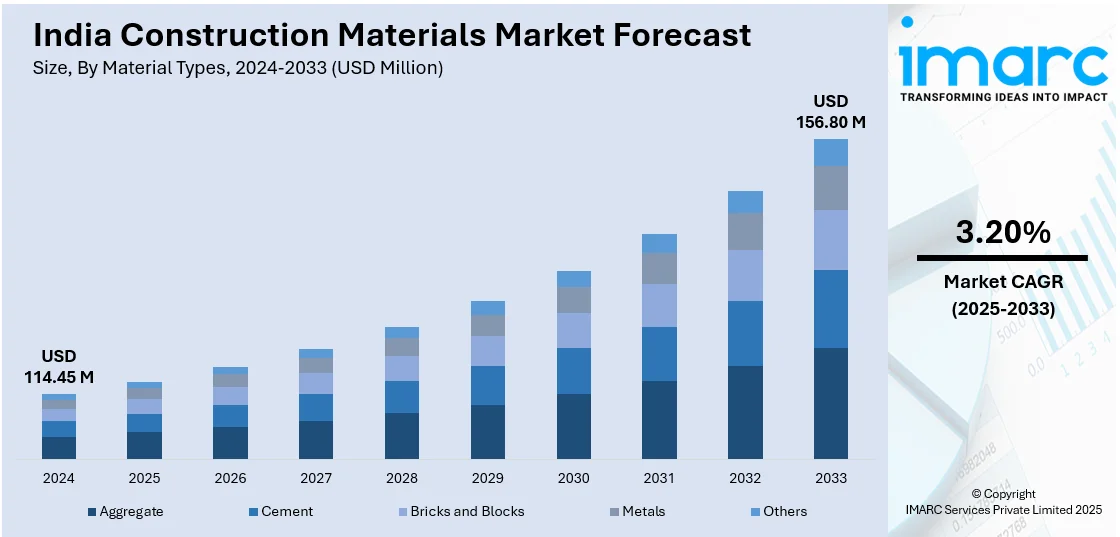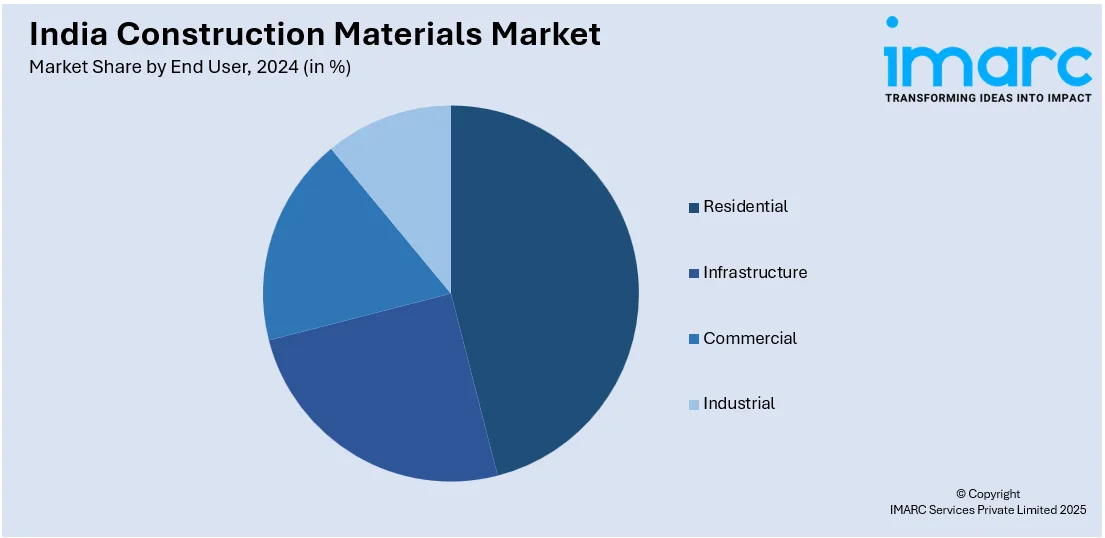
India Construction Materials Market Size, Share, Trends and Forecast by Material Type, End User, and Region, 2025-2033
India Construction Materials Market Overview:
The India construction materials market size reached USD 114.45 Million in 2024. Looking forward, IMARC Group expects the market to reach USD 156.80 Million by 2033, exhibiting a growth rate (CAGR) of 3.20% during 2025-2033. The rapid urbanization, infrastructure development, and increasing real estate investments is driving the India construction materials market growth. Demand for cement, steel, bricks, and advanced materials is rising, supported by government initiatives, smart city projects, and sustainable construction practices, driving market expansion and technological advancements.
|
Report Attribute
|
Key Statistics
|
|---|---|
|
Base Year
|
2024 |
|
Forecast Years
|
2025-2033
|
|
Historical Years
|
2019-2024
|
| Market Size in 2024 | USD 114.45 Million |
| Market Forecast in 2033 | USD 156.80 Million |
| Market Growth Rate 2025-2033 | 3.20% |
India Construction Materials Market Trends:
Growing Demand for Sustainable and Green Building Materials
The India construction materials market share is expanding due a rapid shift towards sustainable and eco-friendly solutions, driven by rising environmental awareness and government initiatives like the Green Building Movement. For instance, as of February 6, 2025, India was still ranked third in the world for LEED (Leadership in Energy and Environmental Design) certifications by the US Green Building Council (USGBC). In 2024, 370 projects totaling 8.50 million gross square meters (about 91.5 million square feet) of space in India were certified LEED. Canada came in second with 10 million GSM certified, while China topped the list with nearly 25 million. Builders and developers are increasingly adopting recycled aggregates, fly ash-based cement, and energy-efficient materials to reduce carbon footprints. The growing preference for sustainable construction is also influenced by regulatory frameworks such as the Energy Conservation Building Code (ECBC). Additionally, the demand for prefabricated and modular materials is rising due to their cost-effectiveness and faster construction timelines. This trend is expected to reshape the industry, promoting sustainability and innovation in material production.

To get more information on this market, Request Sample
Increasing Infrastructure Investments Driving Material Demand
With the Indian government’s continued focus on large-scale infrastructure projects, the demand for construction materials such as cement, steel, and concrete is rising. Initiatives such as the Pradhan Mantri Awas Yojana (PMAY) and the Smart Cities Mission are accelerating material consumption across residential, commercial, and industrial sectors. For instance, the Pradhan Mantri Awas Yojana-Urban (PMAY-U) 2.0 was approved by the Union Cabinet on August 9, 2024, under the direction of Prime Minister Narendra Modi. Its goal is to finance the building, acquisition, or rental of affordable housing for one crore urban poor and middle-class families over the course of the following five years. With a government subsidy of ₹2.30 lakh crore, the project requires a total investment of ₹10 lakh crore. Family incomes up to ₹3 lakh for the Economically Weaker Section (EWS), ₹3 lakh to ₹6 lakh for the Low Income Group (LIG), and ₹6 lakh to ₹9 lakh for the Middle Income Group (MIG) are among the eligibility requirements. The National Infrastructure Pipeline (NIP) also plays a crucial role in boosting demand for high-performance construction materials. Additionally, private sector investments in urban development, roads, and railways are fueling growth. As urbanization expands and infrastructure projects scale up, which in turn is positively impacting India construction materials market outlook.
India Construction Materials Market Segmentation:
IMARC Group provides an analysis of the key trends in each segment of the market, along with forecasts at the country level for 2025-2033. Our report has categorized the market based on material type and end user.
Material Types Insights:
- Aggregate
- Cement
- Bricks and Blocks
- Metals
- Others
The report has provided a detailed breakup and analysis of the market based on the material types. This includes aggregate, cement, bricks and blocks, metals, and others.
End User Insights:

- Residential
- Infrastructure
- Roads
- Bridges
- Waste Management
- Commercial
- Industrial
A detailed breakup and analysis of the market based on the end user have also been provided in the report. This includes residential, infrastructure (roads, bridges, and waste management), commercial, and industrial.
Regional Insights:
- North India
- South India
- East India
- West India
The report has also provided a comprehensive analysis of all the major regional markets, which include North India, South India, East India, and West India.
Competitive Landscape:
The market research report has also provided a comprehensive analysis of the competitive landscape. Competitive analysis such as market structure, key player positioning, top winning strategies, competitive dashboard, and company evaluation quadrant has been covered in the report. Also, detailed profiles of all major companies have been provided.
India Construction Materials Market News:
- March 04, 2025: SIAM Cement BigBloc Construction Technologies Pvt Ltd, a joint venture between BigBloc Construction Ltd and SCG International Corporation Co., Ltd. of Thailand, has begun operations in India with the commercial production of its first plant in Kheda, Gujarat. The project, which includes India's first AAC Wall Plant, will cost approximately INR 65 Crore and have a capacity of 2.5 Lakh Cubic meters annually. Modern building materials should be introduced to Indian markets with this launch.
India Construction Materials Market Report Coverage:
| Report Features | Details |
|---|---|
| Base Year of the Analysis | 2024 |
| Historical Period | 2019-2024 |
| Forecast Period | 2025-2033 |
| Units | Million USD |
| Scope of the Report | Exploration of Historical Trends and Market Outlook, Industry Catalysts and Challenges, Segment-Wise Historical and Future Market Assessment:
|
| Material Types Covered | Aggregate, Cement, Bricks and Blocks, Metals, Others |
| End Users Covered |
|
| Regions Covered | North India, South India, East India, West India |
| Customization Scope | 10% Free Customization |
| Post-Sale Analyst Support | 10-12 Weeks |
| Delivery Format | PDF and Excel through Email (We can also provide the editable version of the report in PPT/Word format on special request) |
Key Questions Answered in This Report:
- How has the India construction materials market performed so far and how will it perform in the coming years?
- What is the breakup of the India construction materials market on the basis of material type?
- What is the breakup of the India construction materials market on the basis of end user?
- What is the breakup of the India construction materials market on the basis of region?
- What are the various stages in the value chain of the India construction materials market?
- What are the key driving factors and challenges in the India construction materials market?
- What is the structure of the India construction materials market and who are the key players?
- What is the degree of competition in the India construction materials market?
Key Benefits for Stakeholders:
- IMARC’s industry report offers a comprehensive quantitative analysis of various market segments, historical and current market trends, market forecasts, and dynamics of the India construction materials market from 2019-2033.
- The research report provides the latest information on the market drivers, challenges, and opportunities in the India construction materials market.
- Porter's five forces analysis assist stakeholders in assessing the impact of new entrants, competitive rivalry, supplier power, buyer power, and the threat of substitution. It helps stakeholders to analyze the level of competition within the India construction materials industry and its attractiveness.
- Competitive landscape allows stakeholders to understand their competitive environment and provides an insight into the current positions of key players in the market.
Need more help?
- Speak to our experienced analysts for insights on the current market scenarios.
- Include additional segments and countries to customize the report as per your requirement.
- Gain an unparalleled competitive advantage in your domain by understanding how to utilize the report and positively impacting your operations and revenue.
- For further assistance, please connect with our analysts.
 Request Customization
Request Customization
 Speak to an Analyst
Speak to an Analyst
 Request Brochure
Request Brochure
 Inquire Before Buying
Inquire Before Buying




.webp)




.webp)












